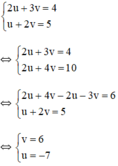Giải các hệ phương trình x - 3 y + 2 x = - 7 - 2 x + 4 y + 3 z = 8 3 x + y - z = 5
Hãy nhập câu hỏi của bạn vào đây, nếu là tài khoản VIP, bạn sẽ được ưu tiên trả lời.

\(\left\{{}\begin{matrix}\left(x-5\right)\left(y-2\right)=\left(x+2\right)\left(y-1\right)\\\left(x-4\right)\left(y+7\right)=\left(x-3\right)\left(y+4\right)\end{matrix}\right.\)
\(\Leftrightarrow\left\{{}\begin{matrix}xy-2x-5y+10=xy-x+2y-2\\xy+7x-4y-28=xy+4x-3y-12\end{matrix}\right.\)
\(\Leftrightarrow\left\{{}\begin{matrix}x+7y=12\\3x-y=16\end{matrix}\right.\) \(\Leftrightarrow\left\{{}\begin{matrix}3x+21y=36\\3x-y=16\end{matrix}\right.\)
\(\Leftrightarrow\left\{{}\begin{matrix}22y=20\\x+7y=12\end{matrix}\right.\) \(\Leftrightarrow\left\{{}\begin{matrix}x=\dfrac{62}{11}\\y=\dfrac{10}{11}\end{matrix}\right.\)

c) \(\left\{{}\begin{matrix}2\left(x-2\right)+3\left(1+y\right)=2\\3\left(x-2\right)-2\left(1+y\right)=-3\end{matrix}\right.\)
\(\Leftrightarrow\left\{{}\begin{matrix}6\left(x-2\right)+9\left(1+y\right)=6\\6\left(x-2\right)-4\left(1+y\right)=-6\end{matrix}\right.\)
\(\Leftrightarrow\left\{{}\begin{matrix}13\left(1+y\right)=12\\2\left(x-2\right)+3\left(1+y\right)=2\end{matrix}\right.\)
\(\Leftrightarrow\left\{{}\begin{matrix}x=\dfrac{21}{13}\\y=-\dfrac{1}{13}\end{matrix}\right.\)
d) \(\left\{{}\begin{matrix}\left(x-5\right)\left(y-2\right)=\left(x+2\right)\left(y-1\right)\\\left(x-4\right)\left(y+7\right)=\left(x-3\right)\left(y+4\right)\end{matrix}\right.\)
\(\Leftrightarrow\left\{{}\begin{matrix}xy-2x-5y+10=xy-x+2y-2\\xy+7x-4y-28=xy+4x-3y-12\end{matrix}\right.\)
\(\Leftrightarrow\left\{{}\begin{matrix}-x-7y=-12\\3x-y=16\end{matrix}\right.\) \(\Leftrightarrow\left\{{}\begin{matrix}-x-7y=-12\\21x-7y=112\end{matrix}\right.\)
\(\Leftrightarrow\left\{{}\begin{matrix}22x=124\\3x-y=16\end{matrix}\right.\) \(\Leftrightarrow\left\{{}\begin{matrix}x=\dfrac{62}{11}\\y=\dfrac{10}{11}\end{matrix}\right.\)

\(a,\Leftrightarrow\left\{{}\begin{matrix}\dfrac{2}{x}-\dfrac{2}{y}=2\\\dfrac{2}{x}-\dfrac{3}{y}=5\end{matrix}\right.\left(x,y\ne0\right)\Leftrightarrow\left\{{}\begin{matrix}-\dfrac{5}{y}=3\\\dfrac{2}{x}-\dfrac{3}{y}=5\end{matrix}\right.\Leftrightarrow\left\{{}\begin{matrix}y=-\dfrac{5}{3}\\\dfrac{2}{x}+\dfrac{9}{5}=5\end{matrix}\right.\\ \Leftrightarrow\left\{{}\begin{matrix}x=\dfrac{5}{8}\\y=-\dfrac{5}{3}\end{matrix}\right.\)
\(b,\Leftrightarrow\left\{{}\begin{matrix}\dfrac{60}{x}-\dfrac{28}{y}=36\\\dfrac{60}{x}-\dfrac{135}{y}=525\end{matrix}\right.\left(x,y\ne0\right)\Leftrightarrow\left\{{}\begin{matrix}\dfrac{4}{x}+\dfrac{9}{y}=35\\-\dfrac{163}{y}=489\end{matrix}\right.\Leftrightarrow\left\{{}\begin{matrix}\dfrac{4}{x}-27=35\\y=-\dfrac{1}{3}\end{matrix}\right.\\ \Leftrightarrow\left\{{}\begin{matrix}x=\dfrac{2}{31}\\y=-\dfrac{1}{3}\end{matrix}\right.\)
a: Ta có: \(\left\{{}\begin{matrix}\dfrac{1}{x}-\dfrac{1}{y}=1\\\dfrac{2}{x}-\dfrac{3}{y}=5\end{matrix}\right.\)
\(\Leftrightarrow\left\{{}\begin{matrix}\dfrac{2}{x}-\dfrac{2}{y}=2\\\dfrac{2}{x}-\dfrac{3}{y}=5\end{matrix}\right.\Leftrightarrow\left\{{}\begin{matrix}\dfrac{1}{y}=-3\\\dfrac{1}{x}-\dfrac{1}{y}=1\end{matrix}\right.\Leftrightarrow\left\{{}\begin{matrix}y=\dfrac{-1}{3}\\\dfrac{1}{x}=1+\dfrac{1}{y}=1+\left(-3\right)=-2\end{matrix}\right.\)
\(\Leftrightarrow\left\{{}\begin{matrix}y=-\dfrac{1}{3}\\x=\dfrac{-1}{2}\end{matrix}\right.\)

e: \(\left\{{}\begin{matrix}\dfrac{1}{x}-\dfrac{1}{y}=1\\\dfrac{3}{x}+\dfrac{4}{y}=5\end{matrix}\right.\Leftrightarrow\left\{{}\begin{matrix}\dfrac{3}{x}-\dfrac{3}{y}=3\\\dfrac{3}{x}+\dfrac{4}{y}=5\end{matrix}\right.\)
\(\Leftrightarrow\left\{{}\begin{matrix}\dfrac{-7}{y}=-2\\\dfrac{1}{x}-\dfrac{1}{y}=1\end{matrix}\right.\Leftrightarrow\left\{{}\begin{matrix}y=\dfrac{7}{2}\\\dfrac{1}{x}=1+\dfrac{2}{7}=\dfrac{9}{7}\end{matrix}\right.\Leftrightarrow\left\{{}\begin{matrix}y=\dfrac{7}{2}\\x=\dfrac{7}{9}\end{matrix}\right.\)

a: \(\left\{{}\begin{matrix}x+4y=-11\\5x-4y=1\end{matrix}\right.\Leftrightarrow\left\{{}\begin{matrix}6x=-10\\x+4y=-11\end{matrix}\right.\Leftrightarrow\left\{{}\begin{matrix}x=\dfrac{-5}{3}\\y=\dfrac{-11-x}{4}=\dfrac{-11+\dfrac{5}{3}}{4}=-\dfrac{7}{3}\end{matrix}\right.\)
b: \(\left\{{}\begin{matrix}2x-y=7\\3x+5y=-22\end{matrix}\right.\Leftrightarrow\left\{{}\begin{matrix}6x-3y=21\\6x+15y=-66\end{matrix}\right.\)
\(\Leftrightarrow\left\{{}\begin{matrix}-18y=78\\2x-y=7\end{matrix}\right.\Leftrightarrow\left\{{}\begin{matrix}y=\dfrac{-13}{3}\\x=\dfrac{y+7}{2}=\dfrac{4}{3}\end{matrix}\right.\)

1. 3x( x - 2 ) - ( x - 2 ) = 0
<=> ( x-2).(3x-1) = 0 => x = 2 hoặc x = \(\dfrac{1}{3}\)
2. x( x-1 ) ( x2 + x + 1 ) - 4( x - 1 )
<=> ( x - 1 ).( x (x^2 + x + 1 ) - 4 ) = 0
(phần này tui giải được x = 1 thôi còn bên kia giải ko ra nha )
3 \(\left\{{}\begin{matrix}\sqrt{5}x-2y=7\\\sqrt{5}x-5y=10\end{matrix}\right.\)<=> \(\left\{{}\begin{matrix}y=-1\\x=\sqrt{5}\end{matrix}\right.\)
\(1. 3x^2 - 7x +2=0\)
=>\(Δ=(-7)^2 - 4.3.2\)
\(= 49-24 = 25\)
Vì 25>0 suy ra phương trình có 2 nghiệm phân biệt:
\(x_1\)=\(\dfrac{-\left(-7\right)+\sqrt{25}}{2.3}=\dfrac{7+5}{6}=2\)
\(x_2\)=\(\dfrac{-\left(-7\right)-\sqrt{25}}{2.3}=\dfrac{7-5}{6}=\dfrac{1}{3}\)

a) Ta có: \(\left\{{}\begin{matrix}3x+y=3\\2x-y=7\end{matrix}\right.\)
\(\Leftrightarrow\left\{{}\begin{matrix}5x=10\\2x-y=7\end{matrix}\right.\Leftrightarrow\left\{{}\begin{matrix}x=2\\y=2x-7=2\cdot2-7=-3\end{matrix}\right.\)
Vậy: Hệ phương trình có nghiệm duy nhất là (x,y)=(2;-3)
b) Ta có: \(7x^2-2x+3=0\)
a=7; b=-2; c=3
\(\Delta=\left(-2\right)^2-4\cdot7\cdot3=4-84=-80< 0\)
Suy ra: Phương trình vô nghiệm
Vậy: \(S=\varnothing\)


Bài toán này có hai cách giải:
Cách 1: Thu gọn từng phương trình ta sẽ thu được phương trình bậc nhất hai ẩn x và y.
Cách 2: Đặt ẩn phụ.
Cách 1:

 (hệ số của y bằng nhau nên ta trừ từng vế hai phương trình)
(hệ số của y bằng nhau nên ta trừ từng vế hai phương trình)

Vậy hệ phương trình có nghiệm duy nhất 

(Nhân hai vế pt 1 với 2; pt 2 với 3 để hệ số của y đối nhau)
 (Hệ số của y đối nhau nên ta cộng từng vế của hai pt)
(Hệ số của y đối nhau nên ta cộng từng vế của hai pt)

Vậy hệ phương trình có nghiệm duy nhất (1; -1).
Cách 2:
a) Đặt x + y = u và x – y = v (*)
Khi đó hệ phương trình trở thành

Thay u = -7 và v = 6 vào (*) ta được hệ phương trình:

Vậy hệ phương trình có nghiệm 
b) Đặt x – 2 = u và y + 1 = v.
Khi đó hệ phương trình trở thành :

+ u = -1 ⇒ x – 2 = -1 ⇒ x = 1.
+ v = 0 ⇒ y + 1 = 0 ⇒ y = -1.
Vậy hệ phương trình có nghiệm (1; -1).
Đưa hệ phương trình về hệ dạng tam giác bằng cách khử dần ẩn số.
Nhân phương trình (1) với 2 rồi cộng với phương trình (2) và nhân phương trình (1) với (3) rồi trừ đi phương trình (3) ta được:
Giải hệ phương trình trên ta được
Vậy hệ phương trình có nghiệm